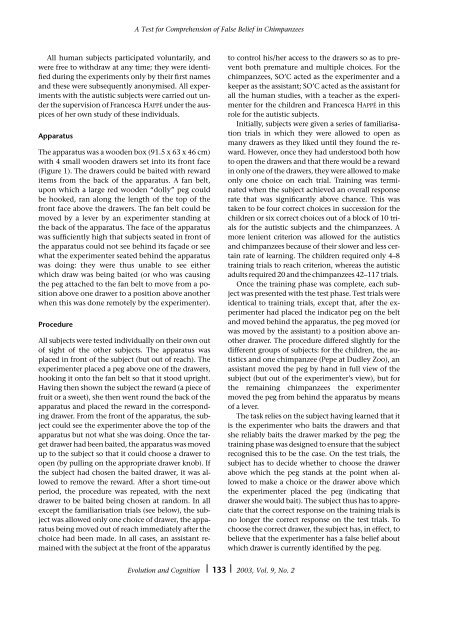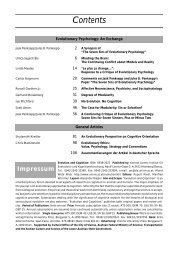Contents - Konrad Lorenz Institute
Contents - Konrad Lorenz Institute
Contents - Konrad Lorenz Institute
Create successful ePaper yourself
Turn your PDF publications into a flip-book with our unique Google optimized e-Paper software.
A Test for Comprehension of False Belief in Chimpanzees<br />
All human subjects participated voluntarily, and<br />
were free to withdraw at any time; they were identified<br />
during the experiments only by their first names<br />
and these were subsequently anonymised. All experiments<br />
with the autistic subjects were carried out under<br />
the supervision of Francesca HAPPÉ under the auspices<br />
of her own study of these individuals.<br />
Apparatus<br />
The apparatus was a wooden box (91.5 x 63 x 46 cm)<br />
with 4 small wooden drawers set into its front face<br />
(Figure 1). The drawers could be baited with reward<br />
items from the back of the apparatus. A fan belt,<br />
upon which a large red wooden “dolly” peg could<br />
be hooked, ran along the length of the top of the<br />
front face above the drawers. The fan belt could be<br />
moved by a lever by an experimenter standing at<br />
the back of the apparatus. The face of the apparatus<br />
was sufficiently high that subjects seated in front of<br />
the apparatus could not see behind its façade or see<br />
what the experimenter seated behind the apparatus<br />
was doing: they were thus unable to see either<br />
which draw was being baited (or who was causing<br />
the peg attached to the fan belt to move from a position<br />
above one drawer to a position above another<br />
when this was done remotely by the experimenter).<br />
Procedure<br />
All subjects were tested individually on their own out<br />
of sight of the other subjects. The apparatus was<br />
placed in front of the subject (but out of reach). The<br />
experimenter placed a peg above one of the drawers,<br />
hooking it onto the fan belt so that it stood upright.<br />
Having then shown the subject the reward (a piece of<br />
fruit or a sweet), she then went round the back of the<br />
apparatus and placed the reward in the corresponding<br />
drawer. From the front of the apparatus, the subject<br />
could see the experimenter above the top of the<br />
apparatus but not what she was doing. Once the target<br />
drawer had been baited, the apparatus was moved<br />
up to the subject so that it could choose a drawer to<br />
open (by pulling on the appropriate drawer knob). If<br />
the subject had chosen the baited drawer, it was allowed<br />
to remove the reward. After a short time-out<br />
period, the procedure was repeated, with the next<br />
drawer to be baited being chosen at random. In all<br />
except the familiarisation trials (see below), the subject<br />
was allowed only one choice of drawer, the apparatus<br />
being moved out of reach immediately after the<br />
choice had been made. In all cases, an assistant remained<br />
with the subject at the front of the apparatus<br />
to control his/her access to the drawers so as to prevent<br />
both premature and multiple choices. For the<br />
chimpanzees, SO’C acted as the experimenter and a<br />
keeper as the assistant; SO’C acted as the assistant for<br />
all the human studies, with a teacher as the experimenter<br />
for the children and Francesca HAPPÉ in this<br />
role for the autistic subjects.<br />
Initially, subjects were given a series of familiarisation<br />
trials in which they were allowed to open as<br />
many drawers as they liked until they found the reward.<br />
However, once they had understood both how<br />
to open the drawers and that there would be a reward<br />
in only one of the drawers, they were allowed to make<br />
only one choice on each trial. Training was terminated<br />
when the subject achieved an overall response<br />
rate that was significantly above chance. This was<br />
taken to be four correct choices in succession for the<br />
children or six correct choices out of a block of 10 trials<br />
for the autistic subjects and the chimpanzees. A<br />
more lenient criterion was allowed for the autistics<br />
and chimpanzees because of their slower and less certain<br />
rate of learning. The children required only 4–8<br />
training trials to reach criterion, whereas the autistic<br />
adults required 20 and the chimpanzees 42–117 trials.<br />
Once the training phase was complete, each subject<br />
was presented with the test phase. Test trials were<br />
identical to training trials, except that, after the experimenter<br />
had placed the indicator peg on the belt<br />
and moved behind the apparatus, the peg moved (or<br />
was moved by the assistant) to a position above another<br />
drawer. The procedure differed slightly for the<br />
different groups of subjects: for the children, the autistics<br />
and one chimpanzee (Pepe at Dudley Zoo), an<br />
assistant moved the peg by hand in full view of the<br />
subject (but out of the experimenter’s view), but for<br />
the remaining chimpanzees the experimenter<br />
moved the peg from behind the apparatus by means<br />
of a lever.<br />
The task relies on the subject having learned that it<br />
is the experimenter who baits the drawers and that<br />
she reliably baits the drawer marked by the peg; the<br />
training phase was designed to ensure that the subject<br />
recognised this to be the case. On the test trials, the<br />
subject has to decide whether to choose the drawer<br />
above which the peg stands at the point when allowed<br />
to make a choice or the drawer above which<br />
the experimenter placed the peg (indicating that<br />
drawer she would bait). The subject thus has to appreciate<br />
that the correct response on the training trials is<br />
no longer the correct response on the test trials. To<br />
choose the correct drawer, the subject has, in effect, to<br />
believe that the experimenter has a false belief about<br />
which drawer is currently identified by the peg.<br />
Evolution and Cognition ❘ 133 ❘ 2003, Vol. 9, No. 2








